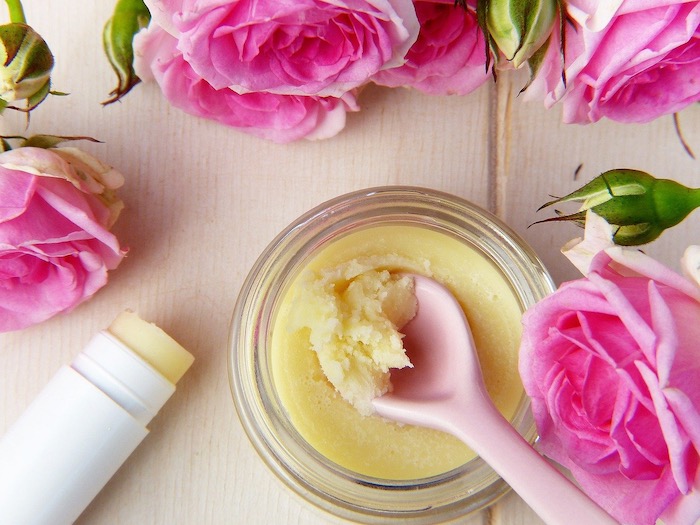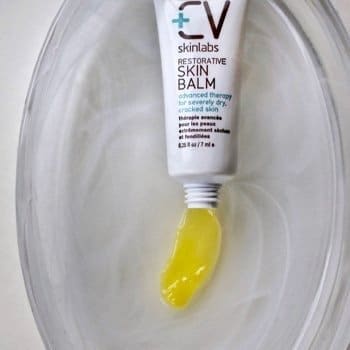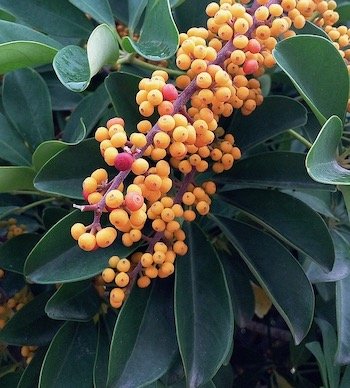
Your skin is sore, sensitive, severely dry, and red, and it’s crying out for a healing balm.
If you find the right one, you’ll experience relief within hours, but that’s not always easy to do. Many so-called healing balms are made with petrolatum, which can do your skin more harm than good.
(Our CV Skinlabs Restorative Skin Balm contains no petrolatum or any other toxic ingredients!)
Let’s look at what makes a good healing balm and why you may want to look for one that includes the amazingly protective sea buckthorn oil.
 What is Healing Balm?
What is Healing Balm?
The official meaning of “balm” is a “fragrant ointment or preparation used to heal or soothe the skin.” The word ointment is key here, as a balm has a unique consistency. It’s somewhere between a solid and a liquid, so it’s thicker than a moisturizer, but not so thick you can’t spread it.
The word “balm” comes from the word “balsam,” which is a gummy substance found in some trees. The original balm tree, also called the Balm of Gilead, is a medium-sized tree that can grow up to 70 feet tall, with dark green leaves and cinnamon-brown bark.
The buds are large and strong-smelling and contain a resin known for its antibacterial, antifungal, and analgesic properties. It’s long been used in cough syrups and first-aid salves to help heal small wounds, cuts, and scrapes.
Today’s healing balms can be made of a variety of different ingredients, but they are all designed to help soothe and stimulate skin renewal.
What is the Difference Between Balm and Moisturizer?
In general, the main difference between a balm, moisturizer, and lotion is in their consistency and thickness. A balm usually has a much lower water content (the best ones have no water at all) and is formulated with a thicker base, such as beeswax and/or oil.
Balms are moisturizing but usually more moisturizing than creams or lotions as they are denser and more intensive. They are made for extra-dry and sensitive areas of the skin.
When Should I Use a Healing Balm?
There are several times when you may need a healing balm for your skin. Here are a few examples:
- To heal dry, flaky skin: When dry skin becomes problematic, it’s time for a balm. During the wintertime especially, skin can become so dry that it cracks and bleeds. A healing balm can help soothe this troubled skin.
- To heal dry, chapped lips: Flaky, chapped lips are uncomfortable and unattractive, and often refuse to heal with only regular lip balm. A healing balm can be used to help renew the fragile skin on the lips and restore a more kissable look and feel.
- To ease sunburn pain: A healing balm can nourish skin damaged by the sun, helping it to feel better and heal faster than it would on its own.
- To ease breast pain: Breastfeeding moms can suffer from dryness and chapping on the nipples. Regular moisturizer usually doesn’t help much, but a healing balm can provide relief.
- To speed healing: Any cuts, scrapes, post-surgery wounds or other minor wounds can benefit from a quality healing balm, as it will encourage the skin to regenerate more quickly while helping to prevent scarring. A good balm will also help you recover faster from cosmetic procedures like chemical peels, laser procedures, microdermabrasion, and even tattoos.
What to Look for in a Healing Balm
The main goal when shopping for a healing balm is to find one that will truly support your skin’s natural healing process. That means it’s best to avoid those with a lot of chemical ingredients, petrolatum, and synthetic fragrances that are likely to stress your skin and leave it just as dry (or drier) as it was before.
Skin that is wounded, dry, and flaking has a compromised skin barrier, which means that the outer layer is damaged. This layer usually forms a protective shield that keeps moisture in and microorganisms out, but when it’s compromised, it develops cracks and openings that allow free radicals, pollution, and bacteria in while allowing moisture to evaporate away.
A good healing balm—like our CV Skinlabs Restorative Skin Balm—will not only provide additional moisture, but protect the damaged area, boost skin renewal, kill bacteria, and prevent oxidative damage. With regular application, such a balm can promote faster and more comfortable healing, while reducing your risk of having a scar once the area is restored.
We recommend that you look for a healing balm that contains a mix of ingredients that will help hydrate and soothe the skin while providing needed relief. One of the best ingredients you can have in your balm is sea buckthorn oil, which has been used to heal skin disorders for centuries.
 What is Sea Buckthorn?
What is Sea Buckthorn?
Sea buckthorn oil comes from the seeds and fruit of the sea buckthorn shrub, which is found on the seacoasts and in northwestern China, Western Europe, and central Asia.
Traditionally, people used the bark and leaves of the plant to treat skin disorders, while using the oil from the berries as a skin softener. The oil is naturally high in essential fatty acids as well as in vitamin E and beta-carotene. It’s also a good source of vitamin C, with higher levels even than an orange.
One of the exciting components of this oil is “superoxide dismutase (SOD),” an antioxidant that is believed to be more powerful even than ginseng and other antioxidants when it comes to fighting free radical damage.
With all these wonderful components and more, sea buckthorn can create miracles on the skin.
Skin Healing Benefits of Sea Buckthorn
Our Restorative Skin Balm contains sea buckthorn oil because we knew way back when we first formulated it how amazing this oil was.
1. Sea buckthorn oil reduces inflammation.
Many skin problems are stubbornly problematic because of inflammation, including eczema, psoriasis, rosacea, and even acne. If we can reduce that inflammation, we can help reduce outbreaks and keep skin looking calm and smooth.
Scientists believe that various components in sea buckthorn give it this power—the antioxidant beta-carotene, omega-3 fatty acids, and vitamins C and E. In one study, the oil was particularly effective against eczema, bringing relief from itching, inflammation, and dryness.
2. Sea buckthorn oil promotes wound healing.
Speed up the healing of that pimple, scratch, or insect bite with sea buckthorn oil.
In 2014, researchers reported that sea buckthorn oil, along with olive oil, was so helpful at healing burn wounds that it could be considered as an alternative dressing for full-thickness burns “because of improved wound healing characteristics and antibacterial property.”
3. Fights bacteria (great for acne sufferers).
Sea buckthorn oil has a natural anti-bacterial property, and it has been recommended for acne sufferers for this reason.
The action is so powerful that researchers discovered it could kill methicillin-resistant Staphylococcus aureus (MRSA)—at levels comparable with the antibiotic vancomycin.
4. Sea buckthorn oil replenishes essential fatty acids.
Essential fatty acids (EFAs) fortify the structure of the skin while adding hydration. Thus they help minimize the appearance of aging. They also help moisturize while controlling excess oil—perfect for acne-prone skin as well as other skin types.
Sea buckthorn oil contains an abundant source of skin-healthy EFAs. It’s great for taking care of dry, flaky, and aging skin. One of its most moisturizing EFAs is omega-7, which is a natural component of skin. Use this natural oil to fade fine lines and wrinkles and revive skin.
5. Sea buckthorn oil regenerates the skin.
Another one of sea buckthorn’s talents is its ability to speed up cell turnover so that skin appears younger-looking. It’s a good source of vitamin A, which encourages the regeneration of skin tissues, creating a smoother, healthier complexion.
The skin is constantly shedding old cells and bringing new ones to the surface. Unfortunately, this process slows as we age. Sea buckthorn oil stimulates skin healing and regeneration to help delay the appearance of dullness and aging.
6. Sea buckthorn oil protects from free-radical damage.
Sea buckthorn oil has a lot of antioxidants in it, including the super powerful SUD. All of these antioxidants help fight the free radical damage that accelerates aging. The oil protects the skin from UV rays while fighting damage from pollution, smoke, poor diet, stress, and more.
The high levels of SUD make this oil particularly powerful when it comes to fighting the elements that cause aging. You also get vitamin C and E, which are both antioxidants, as well as beta-carotene and free-radical fighting flavonoids.
7. Sea buckthorn oil helps lighten age spots and hyperpigmentation.
Sea buckthorn oil contains vitamin C, which helps lighten hyperpigmentation and dark spots. It also contains antioxidant “gallocatechins,” which are effective against excess melanin in the skin.
In a 2013 study on people with melasma (mask-like hyperpigmentation), researchers found that sea buckthorn extract helped decrease levels of melanin and fade the dark areas on the skin.
How Our Healing Balm Can Promote Healthy Skin
In addition to sea buckthorn oil, our Restorative Skin Balm also includes many other healing ingredients. Some examples include natural oils, beeswax, shea butter, Reishi mushroom, turmeric, and bisabolol.
Apply some to your dry, flaky, red, and irritated skin. It goes to work moisturizing, protecting, soothing, and helping skin to repair itself. Use the balm to:
- treat dry and flaky skin
- help heal sunburns and redness from cosmetic treatments
- soothe scalp itch
- battle dermatitis and eczema
- reduce scarring
- moisturize cuticles and lips
- heal acne
- speed tattoo healing
Give it a try today! Your skin will be grateful.
When do you use a healing balm?
Sources
Edraki M, et al., “Healing effect of sea buckthorn, olive oil, and their mixture on full-thickness burn wounds,” Adv Skin Wound Care, July 2014; 27(7):317-23, https://www.ncbi.nlm.nih.gov/pubmed/24932952.
Qadir Ml, et al., “Report-Antibacterial activity of sea buckthorn (Hippophae rhamnoides L.), against methicillin resistant Staphylococcus aureus (MRSA),” Pak J Pharm Sci., September 2016; 29(5):1711-1713, https://www.ncbi.nlm.nih.gov/pubmed/27731833.
Barkat Ali Khan, et al., “Whitening efficacy of plant extracts including Hippophae rhamnoides and Cassia fistula extracts on the skin of Asian patients with melasma,” Postepy Dermatol Alergol., August 2013; 30(4):226-232, https://www.ncbi.nlm.nih.gov/pmc/articles/PMC3834707/.

